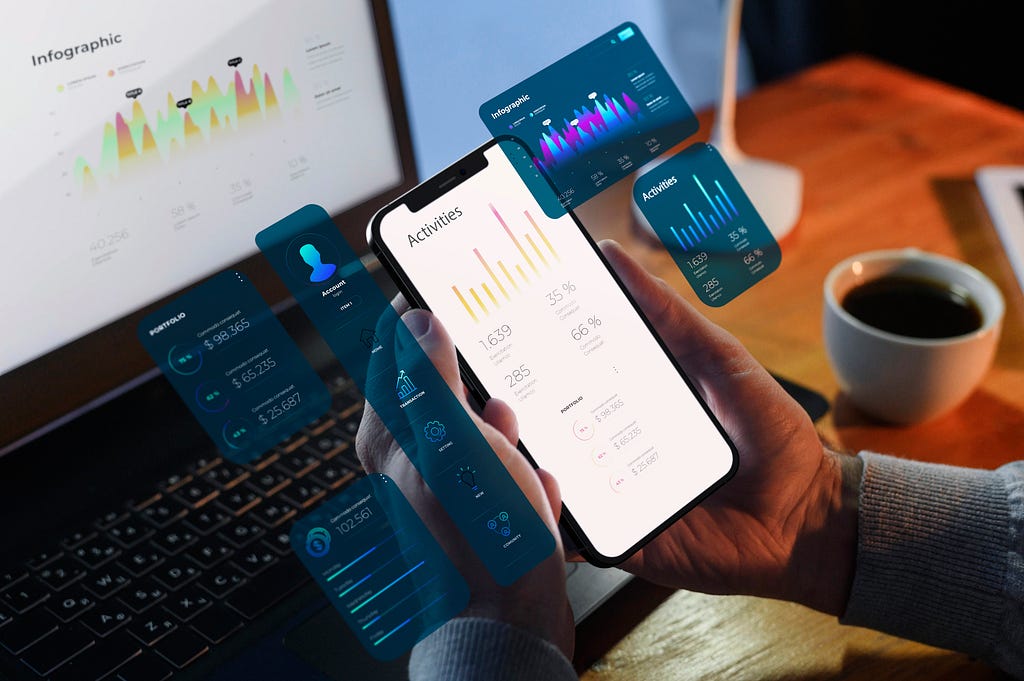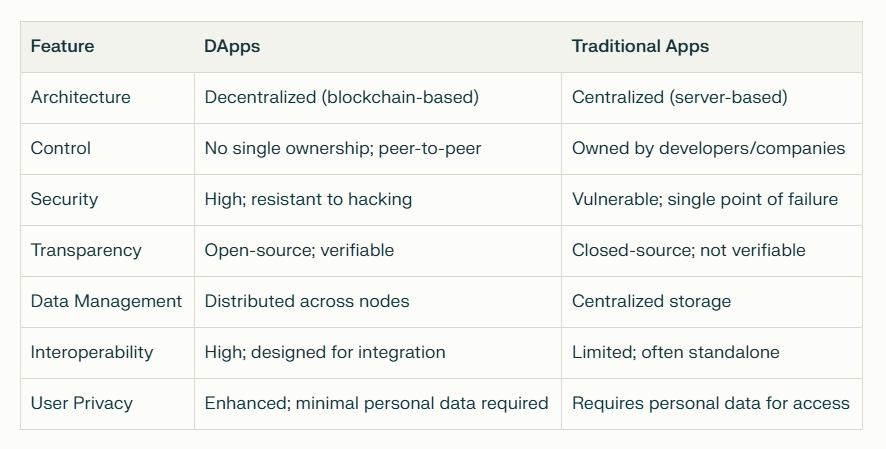
Decentralized applications (DApps) represent a significant shift in how we interact with technology and the internet. Built on blockchain technology, DApps provide a new framework for application development that prioritizes user control, security, and transparency. This blog explores the benefits of DApps, their potential use cases, and a guide on how to build them.
Understanding DApps
DApps are applications that operate on a decentralized network, typically utilizing blockchain technology. Unlike traditional applications that rely on centralized servers and authorities, DApps function through a peer-to-peer network, allowing users to interact directly without intermediaries. This fundamental difference is what sets DApps apart and contributes to their growing popularity.
DApps (decentralized applications) and traditional apps differ fundamentally in their architecture, control, and security features. Here are the key differences:
1. Architecture
DApps: Operate on decentralized networks, typically utilizing blockchain technology. This means they do not rely on a single server or authority, allowing for greater resilience against failures and attacks.
Traditional Apps: Function on centralized servers controlled by a single organization or entity. This centralization can lead to vulnerabilities, as the entire application is dependent on the health and security of that server.
2. Control and Ownership
DApps: Are not owned or controlled by any individual or organization. They run on a peer-to-peer network, which means that all users have equal control and ownership over the application.
Traditional Apps: Controlled by the developers or companies that create them. These entities have the power to modify, shut down, or restrict access to the app at any time.
3. Security
DApps: Utilize blockchain’s inherent security features, making them less susceptible to hacking and data breaches. Data is stored across multiple nodes, which enhances its integrity and availability.
Traditional Apps: More vulnerable to attacks since they are hosted on centralized servers. A successful breach can compromise all user data stored on that server.
4. Transparency
DApps: Generally open-source, allowing anyone to inspect the code and verify its functionality. This transparency fosters trust among users.
Traditional Apps: Often closed-source, meaning users cannot see the underlying code. This lack of transparency can lead to mistrust regarding data handling practices.
5. Data Management
DApps: Data is replicated across multiple nodes in the network, making it more resistant to censorship and tampering.
Traditional Apps: Data is typically stored in a single location (the server), making it easier for unauthorized parties to access or manipulate it.
6. Interoperability
DApps: Designed to be interoperable with other applications and services within the blockchain ecosystem, facilitating broader integration and collaboration.
Traditional Apps: Often lack interoperability, which can limit their functionality and integration with other systems.
7. User Privacy
DApps: Users do not need to provide personal information to access services, preserving their privacy and reducing data exposure risks.
Traditional Apps: Usually require users to submit personal data for account creation and service access, increasing privacy concerns.
Summary Table

These differences highlight why DApps are gaining traction as a preferred choice for many businesses seeking secure, transparent, and user-centric applications in an increasingly digital world.
Benefits of DApps
1. User Control: DApps give users complete control over their data and digital assets. Users can manage their information without relying on third-party services, which often collect and monetize user data.
2. Increased Security: By utilizing blockchain technology, DApps are inherently more secure than traditional applications. The decentralized nature means there is no single point of failure, making it difficult for hackers to compromise the system. Additionally, the use of cryptographic techniques ensures that data remains immutable and protected from unauthorized alterations.
3. Cost Efficiency: DApps eliminate the need for intermediaries, which reduces transaction costs significantly. Users typically pay only minimal fees associated with blockchain transactions, making financial interactions more affordable.
4. Transparency: The open-source nature of DApps allows users to verify code and transactions independently. This transparency builds trust among users as they can see how the application operates and how their data is handled.
5. Censorship Resistance: Since DApps are decentralized, they are less susceptible to censorship or shutdown by any single entity. This feature is particularly appealing for users seeking freedom of expression in digital spaces.
6. Interoperability: Many DApps are designed to work across multiple blockchain platforms, enabling them to communicate and share data seamlessly. This cross-chain compatibility expands the potential use cases for DApps across various industries.
Use Cases for DApps
DApps have a wide range of applications across various sectors:
Finance: Decentralized finance (DeFi) platforms allow users to lend, borrow, and trade cryptocurrencies without traditional banks. These platforms often provide higher interest rates for savings and lower costs for loans compared to conventional financial institutions.
Supply Chain Management: DApps can enhance transparency and traceability in supply chains by recording every transaction on a blockchain. This visibility helps reduce fraud and improve efficiency in logistics.
Healthcare: In healthcare, DApps can securely store patient records on a blockchain, ensuring that only authorized individuals have access to sensitive information while maintaining patient privacy.
Gaming: The gaming industry is seeing a rise in blockchain-based games where players can own in-game assets as NFTs (non-fungible tokens). These assets can be traded or sold outside the game environment, providing real-world value to players.
Social Media: Decentralized social media platforms allow users to share content without fear of censorship or data exploitation by large corporations. Users retain ownership of their content and can monetize it directly.
How to Build a DApp
Building a DApp involves several key steps:
1. Define Your Idea: Start by identifying the problem your DApp will solve or the service it will provide. Consider your target audience and how they will benefit from your application.
2. Choose a Blockchain Platform: Select an appropriate blockchain platform based on your requirements. Ethereum is popular for its robust smart contract capabilities, but other platforms like Binance Smart Chain or Solana may also be suitable depending on your needs.
3. Develop Smart Contracts: Smart contracts are self-executing contracts with terms written directly into code. They automate processes within your DApp and ensure trustless interactions between users.
4. Create the Frontend: Design a user-friendly interface that allows users to interact with your DApp easily. The frontend can be built using standard web technologies like HTML, CSS, and JavaScript.
5. Integrate with Wallets: To facilitate transactions within your DApp, integrate cryptocurrency wallets such as MetaMask or Trust Wallet so users can manage their digital assets directly from your application.
6. Test Your DApp: Conduct thorough testing to identify bugs or vulnerabilities before launching your application publicly. Testing should include both functional tests of smart contracts and user experience tests for the frontend.
7. Deploy Your DApp: Once testing is complete, deploy your smart contracts on the chosen blockchain network and launch your frontend application.
8. Promote Your DApp: After deployment, promote your application through various channels to attract users and build a community around your project.
Conclusion
DApps represent a significant advancement in how we interact with technology online by promoting user control, security, and transparency while reducing costs associated with traditional applications. As awareness of blockchain technology grows, so too will the adoption of decentralized applications across various industries.
If you’re considering developing a DApp that harnesses these benefits for your business or project, Codezeros is here to assist you in navigating this innovative space effectively.
This blog provides an overview of what makes DApps crucial for the future of the internet while offering insights into their dapp development company process tailored for businesses looking to explore this exciting frontier in technology.
Venture
Thank you for being a part of the community! Before you go:
- Be sure to clap and follow the writer ️👏️️
- Follow us: X | LinkedIn | YouTube | Discord | Newsletter | Podcast
- Create a free AI-powered blog on Differ.
- Visit our platforms: CoFeed | In Plain English | Venture | Cubed
What Makes DApps the Future of the Internet: Benefits and How to Build was originally published in Venture on Medium, where people are continuing the conversation by highlighting and responding to this story.








